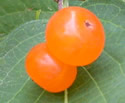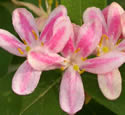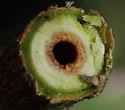Lonicera tatarica (Tatarian Honeysuckle)
| Also known as: | |
|---|---|
| Genus: | Lonicera |
| Family: | Caprifoliaceae (Honeysuckle) |
| Life cycle: | perennial woody |
| Origin: | Eurasia |
| Status: |
|
| Habitat: | part shade, sun; disturbed soil; fields, fence rows, forests, woodland edges, thickets, landscape plantings |
| Bloom season: | May - June |
| Plant height: | 5 to 10 feet |
| Wetland Indicator Status: | GP: FACU MW: FACU NCNE: FACU |
| MN county distribution (click map to enlarge): |  |
| National distribution (click map to enlarge): |  |
Pick an image for a larger view. See the glossary for icon descriptions.
Detailed Information
Flower: 

![[photo of flowers]](/udata/r9ndp23q/pd3/lonicera-tatarica-8975-1-t.jpg) Pairs of irregular flowers arising from leaf axils all along first year branches. Flowers are deep rosy to light pink, sometimes white, ¾ to 1 inch long, with a slender tube and 2 lips, the upper lip with 4 lobes, the middle 2 erect and fused near the base, the lateral lobes spreading; the lower lip is reflexed down, slightly longer than the upper, and both longer than the floral tube. Outer surfaces are hairless. Protruding from the tube are 5 yellow-tipped stamens and a slender, white style with a green, dome-shaped stigma at the tip.
Pairs of irregular flowers arising from leaf axils all along first year branches. Flowers are deep rosy to light pink, sometimes white, ¾ to 1 inch long, with a slender tube and 2 lips, the upper lip with 4 lobes, the middle 2 erect and fused near the base, the lateral lobes spreading; the lower lip is reflexed down, slightly longer than the upper, and both longer than the floral tube. Outer surfaces are hairless. Protruding from the tube are 5 yellow-tipped stamens and a slender, white style with a green, dome-shaped stigma at the tip.
![[photo of flower stalk and bracts]](/udata/r9ndp23q/pd3/lonicera-tatarica-6-16-78932-5-t.jpg) The floral tube is slightly swollen on one side near the base. At the base of the tube is a green, egg-shaped ovary with 5 lance-oblong lobes at the tip. The pair of flowers sits at the tip of a hairless stalk up to about 1 inch long with a pair of leaf-like bracts between the stalk and ovary. The bracts are lance-oblong, spreading, hairless, and longer or shorter than the ovary. At the base of each ovary is a second bract (bracteole) that is oval to egg-shaped, hairless, and half or less as long as the ovary at anthesis.
The floral tube is slightly swollen on one side near the base. At the base of the tube is a green, egg-shaped ovary with 5 lance-oblong lobes at the tip. The pair of flowers sits at the tip of a hairless stalk up to about 1 inch long with a pair of leaf-like bracts between the stalk and ovary. The bracts are lance-oblong, spreading, hairless, and longer or shorter than the ovary. At the base of each ovary is a second bract (bracteole) that is oval to egg-shaped, hairless, and half or less as long as the ovary at anthesis.
Leaves and stems: 

![[photo of leaves]](/udata/r9ndp23q/trees/lonicera-tatarica-tartarian-honeysuckle_0520_171749-t.jpg) Leaves are opposite, 1 to 2½ inches long, ½ to 1 inch wide, egg-shaped to lance-oblong, widest at or below the middle, blunt or pointed at the tip, rounded to straight across to somewhat heart-shaped at the base, with a short, hairless stalk. Surfaces are hairless, edges are toothless, sometimes with scattered hairs around the edge. Color is green to blue-green.
Leaves are opposite, 1 to 2½ inches long, ½ to 1 inch wide, egg-shaped to lance-oblong, widest at or below the middle, blunt or pointed at the tip, rounded to straight across to somewhat heart-shaped at the base, with a short, hairless stalk. Surfaces are hairless, edges are toothless, sometimes with scattered hairs around the edge. Color is green to blue-green.
![[photo of peeling bark]](/udata/r9ndp23q/pd3/lonicera-tatarica-5-16-19-t.jpg) Twigs are green to brown, hairless, and hollow with a brown pith. Older bark is gray and often peeling in strips. Stems are multiple from the base and many-branched, often forming dense thickets.
Twigs are green to brown, hairless, and hollow with a brown pith. Older bark is gray and often peeling in strips. Stems are multiple from the base and many-branched, often forming dense thickets.
Fruit: 
![[photo of fruit]](/udata/r9ndp23q/pd3/lonicera-tatarica-78902-t.jpg) Fruit is a bright red, shiny, round berry, ¼ to 1/3 inch in diameter, containing a few seeds.
Fruit is a bright red, shiny, round berry, ¼ to 1/3 inch in diameter, containing a few seeds.
Notes:
Tatarian Honeysuckle is one of four exotic invasive Honeysuckles to grace our landscape. Of these four, the key distinguishing characteristics of Tatarian are the combination of: usually pink flowers, flowers and fruits at the end of a long stalk, and leaves, stems, stalks and bracts are hairless or at most have just a few hairs. By comparison, Amur Honeysuckle (Lonicera maackii) and Morrow's Honeysuckle (Lonicera morrowii) have hairy leaves and white flowers that fade to yellowish as they wither, and the bracteoles on Morrow's are half or more as long as the ovary at anthesis where Tatarian bracteoles are half or less. Showy Honeysuckle (Lonicera ×bella) is a cultivated, fertile hybrid between L. tatarica and L. morrowii, usually has at least some hairs on leaves and bracts, and its flowers fade to yellowish as they wither, where L. tatarica flowers do not. The hybrid is actually more common than either parent and is often mistaken for one of them, L. tatarica in particular.
All of these exotic Honeysuckles are problematic in natural areas. They can create dense thickets, they leaf out early and stay leafed out later than most other shrubs, all of which robs sunlight, moisture and nutrients from other plants in the understory. Birds eat the fruits and easily spread the seeds to new locations. The exotics are fairly easy to distinguish from the MN native Lonicera species: most natives are vines not shrubs, the native shrubs do not have the vigor or stature of the exotics, nor do they have pink or white flowers, and the twigs are solid where the exotics are hollow.
Native Plant Nurseries, Restoration and Landscaping Services ↓
More photos
 Tatarian Honeysuckle shrub
Tatarian Honeysuckle shrub Tatarian Honeysuckle shrub
Tatarian Honeysuckle shrub Tatarian Honeysuckle shrub
Tatarian Honeysuckle shrub leaves are hairless
leaves are hairless fruit is red or orange
fruit is red or orange flower color is variable
flower color is variable exotic Honeysuckles have hollow twigs with brown pith
exotic Honeysuckles have hollow twigs with brown pith
Photos by K. Chayka taken in Ramsey County. Photos courtesy Peter M. Dziuk taken in Anoka, Chisago and Roseau counties.
Comments
Have you seen this plant in Minnesota, or have any other comments about it?
on: 2017-05-31 19:06:54
This plant appeared a couple of years ago in my raspberry patch. Trees frequently come up in the area, so I didn't pay much attention until it started blooming about a week ago. It's pretty, but is this something I should remove? Thank you!
on: 2017-05-31 20:31:23
Joanne, it is invasive and will spread. Get rid of it while you can
on: 2019-05-10 10:07:22
I have a very old, large tatarian honeysuckle that I'd like to replace. It is in a shady area under some large oaks and it provides screening into the backyard since we live on a corner. I'd prefer a native. I've tried a serviceberry but it got eaten by rabbits over the winter. They seem to leave the old honeysuckle alone. Maybe it's too old to be tasty. What would you suggest?
on: 2019-05-10 14:24:02
Angela, rabbits and deer will go after unprotected plants, especially anything young and tender. Wrap the trunk or cage it to give it some protection until it's established. Other native shrubs you might try: a Viburnum or a dogwood.
on: 2020-07-24 15:44:13
My neighbor asked me to identify this shrub on her property. I'm pretty sure it's this tatarian honeysuckle.
on: 2021-07-25 21:59:34
I believe we have a Tatarian Honeysuckle bush and our 2-yr old ate a couple of berries off of it. After further research, I learned the berries are poisonous. Are just a couple of berries a concern? (We are removing the bush immediately!)
on: 2022-06-06 14:22:29
We seem to have several of these at the edges of the woods on our property. Thank you for the help identifying it so we can move forward with eradication.
on: 2023-05-25 12:30:17
I believe we have several, if not at least 5-6 well established honeysuckle growing on the edge of our property. We are currently battling the buckthorn in other parts of the yard and noticed in the areas with the honeysuckle, less buckthorn is present. My question is, which is worse to have and how do I prioritize removal?
on: 2023-05-25 18:41:40
Sarah, both are very bad plants. I think the buckthorn spreads faster but if you only have a few honeysuckle it may be a good move to get rid of it while it's still a relatively small problem.
on: 2023-08-03 12:29:25
Can my chickens eat the berries of the honeysuckles
on: 2023-08-03 19:06:29
Gale, if birds in general eat the fruit then there is no reason to believe chickens won't consume them. Having said that, I don't know how appetizing these are to birds, or whether they consume them at all.
on: 2023-12-01 09:15:22
Anyone have tips on removal? I found maybe a dozen or so on my property and plan to eliminate them. I'm thinking a cut-stump method painting the stumps with roundup.
on: 2023-12-01 10:28:21
C Kitzmann, the DNR has some info on invasive honeysuckles that might be helpful.






